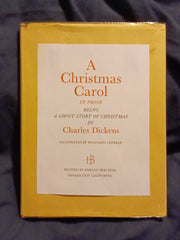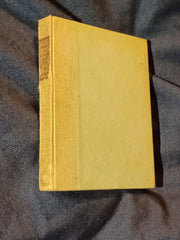Alchemical Hieroglyphics by Nicolas Flammel (Flamel). Heptangle Books.
Alchemical Hieroglyphics, which were caused to be painted upon an arch in St. Innocents Church yard in Paris by Nicolas Flammel (Flamel). Translated out of the French in 1624 by: Eirenaeus Orandus. Heptangle Books. 1980. ISBN-10:0935214046. 5 3/4" x 8 1/2" 89+ Page Hardcover with no dust jacket. Cloth spine with paper label and paper covered boards. Some scuffing on the spine label. Some spots of soiling on the cloth spine. On cover tips, and one spot on the top cover edge, paper has worn through. Light foxing on the top of the page block. A few pin-head size spots inside the front cover. A light smudge between pages 12 and 13. No other previous owner markings. No tears, folds or creases to pages. Binding is tight with no looseness to pages. Not ex-library, not remaindered and not a facsimile reprint. For sale by Jon Wobber, bookseller since 1978. IG21a
"Nicolas Flamel (French: [nikɔla flamɛl]; c. 1330 – 22 March 1418)[1] was a French scribe and manuscript seller. After his death, Flamel developed a reputation as an alchemist believed to have created and discovered the philosopher's stone and to have thereby achieved immortality. These legendary accounts first appeared in the 17th century.
According to texts ascribed to Flamel almost 200 years after his death, he had learned alchemical secrets from a Jewish converso on the road to Santiago de Compostela. He has since appeared as a legendary alchemist in various fictional works.
The historical Flamel lived in Paris in the 14th and 15th centuries, and his life is one of the best documented in the history of medieval alchemy.[2] He ran two shops as a scribe and married Perenelle in 1368. She brought the wealth of two previous husbands to the marriage. The French Catholic couple owned several properties and contributed financially to churches, sometimes by commissioning sculptures.[3] Later in life, they were noted for their wealth and philanthropy.
Flamel lived into his 80s, and in 1410 designed his own tombstone, which was carved with the images of Christ, St. Peter, and St. Paul. The tombstone is preserved at the Musée de Cluny in Paris. Records show that Flamel died in 1418.[4] He was buried in Paris at the end of the nave of the former Church of Saint-Jacques-de-la-Boucherie.[5] His will, dated 22 November 1416, indicates that he was generous but that he did not have the extraordinary wealth of later alchemical legend. There is no indication that the real Flamel of history was involved in alchemy, pharmacy or medicine.
Flamel has been portrayed in popular fiction as a legendary figure who holds the key to immortality or the philosopher's stone. For example, in Victor Hugo's 1831 novel Notre Dame de Paris, the tragic main character Claude Frollo is a young priest and alchemist who spends much of his time studying the carvings in Les Innocents, trying to fathom Flamel's secrets. Into the twentieth and twenty-first centuries, works such as Harry Potter (1997 to the 2022 spinoff film), Fullmetal Alchemist (2001–2010), The Secrets of the Immortal Nicholas Flamel (2007–2012), and As Above, So Below (2014) have propagated the legend of Nicolas Flamel. He is also mentioned in the book The Alchemyst by Michael Scott (Published 2007, Delacorte Press), as the main character." - Wikipedia
"Nicolas Flamel (French: [nikɔla flamɛl]; c. 1330 – 22 March 1418)[1] was a French scribe and manuscript seller. After his death, Flamel developed a reputation as an alchemist believed to have created and discovered the philosopher's stone and to have thereby achieved immortality. These legendary accounts first appeared in the 17th century.
According to texts ascribed to Flamel almost 200 years after his death, he had learned alchemical secrets from a Jewish converso on the road to Santiago de Compostela. He has since appeared as a legendary alchemist in various fictional works.
The historical Flamel lived in Paris in the 14th and 15th centuries, and his life is one of the best documented in the history of medieval alchemy.[2] He ran two shops as a scribe and married Perenelle in 1368. She brought the wealth of two previous husbands to the marriage. The French Catholic couple owned several properties and contributed financially to churches, sometimes by commissioning sculptures.[3] Later in life, they were noted for their wealth and philanthropy.
Flamel lived into his 80s, and in 1410 designed his own tombstone, which was carved with the images of Christ, St. Peter, and St. Paul. The tombstone is preserved at the Musée de Cluny in Paris. Records show that Flamel died in 1418.[4] He was buried in Paris at the end of the nave of the former Church of Saint-Jacques-de-la-Boucherie.[5] His will, dated 22 November 1416, indicates that he was generous but that he did not have the extraordinary wealth of later alchemical legend. There is no indication that the real Flamel of history was involved in alchemy, pharmacy or medicine.
Flamel has been portrayed in popular fiction as a legendary figure who holds the key to immortality or the philosopher's stone. For example, in Victor Hugo's 1831 novel Notre Dame de Paris, the tragic main character Claude Frollo is a young priest and alchemist who spends much of his time studying the carvings in Les Innocents, trying to fathom Flamel's secrets. Into the twentieth and twenty-first centuries, works such as Harry Potter (1997 to the 2022 spinoff film), Fullmetal Alchemist (2001–2010), The Secrets of the Immortal Nicholas Flamel (2007–2012), and As Above, So Below (2014) have propagated the legend of Nicolas Flamel. He is also mentioned in the book The Alchemyst by Michael Scott (Published 2007, Delacorte Press), as the main character." - Wikipedia















